Tighter Control by Chymotrypsin C (CTRC) Explains Lack of Association between Human Anionic Trypsinogen and Hereditary Pancreatitis
- PMID: 27129265
- PMCID: PMC4933207
- DOI: 10.1074/jbc.M116.725374
Tighter Control by Chymotrypsin C (CTRC) Explains Lack of Association between Human Anionic Trypsinogen and Hereditary Pancreatitis
Abstract
The human pancreas expresses two major trypsinogen isoforms, cationic trypsinogen (PRSS1) and anionic trypsinogen (PRSS2). Mutations in PRSS1 cause hereditary pancreatitis by altering cleavage of regulatory nick sites by chymotrypsin C (CTRC) resulting in reduced trypsinogen degradation and increased autoactivation. Despite 90% identity with PRSS1 and a strong propensity for autoactivation, mutations in PRSS2 are not found in hereditary pancreatitis suggesting that activation of this isoform is more tightly regulated. Here, we demonstrated that CTRC promoted degradation and thereby markedly suppressed autoactivation of human anionic trypsinogen more effectively than previously observed with cationic trypsinogen. Increased sensitivity of anionic trypsinogen to CTRC-mediated degradation was due to an additional cleavage site at Leu-148 in the autolysis loop and the lack of the conserved Cys-139-Cys-206 disulfide bond. Significant stabilization of anionic trypsinogen against degradation was achieved by simultaneous mutations of CTRC cleavage sites Leu-81 and Leu-148, autolytic cleavage site Arg-122, and restoration of the missing disulfide bridge. This stands in stark contrast to cationic trypsinogen where single mutations of either Leu-81 or Arg-122 resulted in almost complete resistance to CTRC-mediated degradation. Finally, processing of the trypsinogen activation peptide at Phe-18 by CTRC inhibited autoactivation of anionic trypsinogen, although cationic trypsinogen was strongly stimulated. Taken together, the observations indicate that human anionic trypsinogen is controlled by CTRC in a manner that individual natural mutations are unlikely to increase stability enough to promote intra-pancreatic activation. This unique biochemical property of anionic trypsinogen explains the lack of association of PRSS2 mutations with hereditary pancreatitis.
Keywords: chymotrypsin; chymotrypsin C; pancreas; serine protease; trypsin; trypsinogen.
© 2016 by The American Society for Biochemistry and Molecular Biology, Inc.
Figures
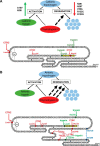
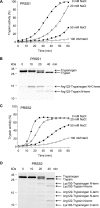
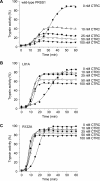
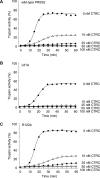
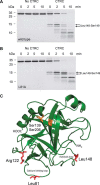
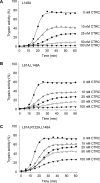
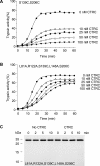

Similar articles
-
Autoactivation of mouse trypsinogens is regulated by chymotrypsin C via cleavage of the autolysis loop.J Biol Chem. 2013 Aug 16;288(33):24049-62. doi: 10.1074/jbc.M113.478800. Epub 2013 Jun 27. J Biol Chem. 2013. PMID: 23814066 Free PMC article.
-
Robust autoactivation, chymotrypsin C independence and diminished secretion define a subset of hereditary pancreatitis-associated cationic trypsinogen mutants.FEBS J. 2013 Jun;280(12):2888-99. doi: 10.1111/febs.12292. Epub 2013 May 16. FEBS J. 2013. PMID: 23601753 Free PMC article.
-
Increased activation of hereditary pancreatitis-associated human cationic trypsinogen mutants in presence of chymotrypsin C.J Biol Chem. 2012 Jun 8;287(24):20701-10. doi: 10.1074/jbc.M112.360065. Epub 2012 Apr 26. J Biol Chem. 2012. PMID: 22539344 Free PMC article.
-
Molecular pathology and evolutionary and physiological implications of pancreatitis-associated cationic trypsinogen mutations.Hum Genet. 2001 Sep;109(3):245-52. doi: 10.1007/s004390100580. Hum Genet. 2001. PMID: 11702203 Review.
-
Genetics of pancreatitis: a guide for clinicians.Dig Dis. 2010;28(6):702-8. doi: 10.1159/000324276. Epub 2011 Apr 27. Dig Dis. 2010. PMID: 21525753 Review.
Cited by
-
Structural Basis of the Pancreatitis-Associated Autoproteolytic Failsafe Mechanism in Human Anionic Trypsin.J Inflamm Res. 2022 Jun 24;15:3633-3642. doi: 10.2147/JIR.S367699. eCollection 2022. J Inflamm Res. 2022. PMID: 35775010 Free PMC article.
-
Natural single-nucleotide deletion in chymotrypsinogen C gene increases severity of secretagogue-induced pancreatitis in C57BL/6 mice.JCI Insight. 2019 Jun 18;4(14):e129717. doi: 10.1172/jci.insight.129717. Print 2019 Jul 25. JCI Insight. 2019. PMID: 31211695 Free PMC article.
-
Genetics, Cell Biology, and Pathophysiology of Pancreatitis.Gastroenterology. 2019 May;156(7):1951-1968.e1. doi: 10.1053/j.gastro.2018.11.081. Epub 2019 Jan 18. Gastroenterology. 2019. PMID: 30660731 Free PMC article. Review.
-
Genetic Risk in Chronic Pancreatitis: The Trypsin-Dependent Pathway.Dig Dis Sci. 2017 Jul;62(7):1692-1701. doi: 10.1007/s10620-017-4601-3. Epub 2017 May 23. Dig Dis Sci. 2017. PMID: 28536777 Free PMC article. Review.
-
Inactivation of mesotrypsin by chymotrypsin C prevents trypsin inhibitor degradation.J Biol Chem. 2020 Mar 13;295(11):3447-3455. doi: 10.1074/jbc.RA120.012526. Epub 2020 Feb 3. J Biol Chem. 2020. PMID: 32014997 Free PMC article.
References
-
- Chen J.-M., and Ferec C. (2000) Genes, cloned cDNAs, and proteins of human trypsinogens and pancreatitis-associated cationic trypsinogen mutations. Pancreas 21, 57–62 - PubMed
-
- Guy O., Lombardo D., Bartelt D. C., Amic J., and Figarella C. (1978) Two human trypsinogens. Purification, molecular properties, and N-terminal sequences. Biochemistry 17, 1669–1675 - PubMed
-
- Scheele G., Bartelt D., and Bieger W. (1981) Characterization of human exocrine pancreatic proteins by two-dimensional isoelectric focusing/sodium dodecyl sulfate gel electrophoresis. Gastroenterology 80, 461–473 - PubMed
-
- Rinderknecht H., Stace N. H., and Renner I. G. (1985) Effects of chronic alcohol abuse on exocrine pancreatic secretion in man. Dig. Dis. Sci. 30, 65–71 - PubMed
Publication types
MeSH terms
Substances
Associated data
- Actions
Grants and funding
LinkOut - more resources
Full Text Sources
Other Literature Sources
Medical

